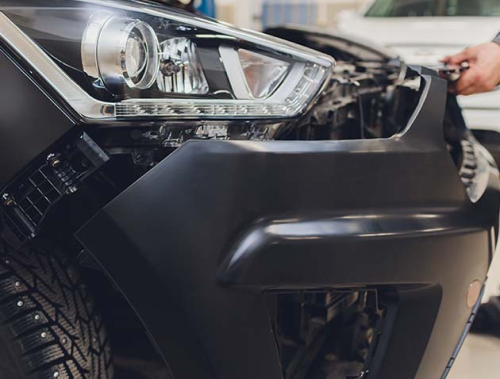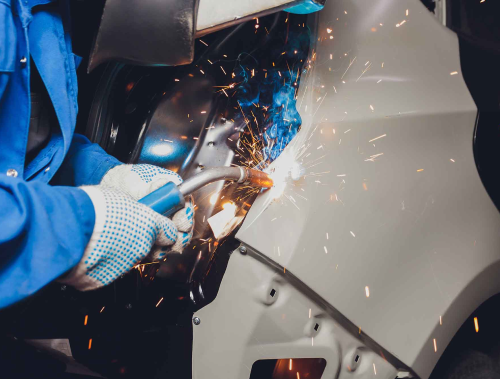Managing a fleet involves more than just keeping your business’s vehicles on the road. It requires a proactive approach to vehicle maintenance and repairs to keep business operations running smoothly. Understanding common maintenance tasks and potential repair issues is crucial for fleet managers, business owners, and transportation companies. Read on for practical tips and preventative measures to help reduce fleet costs and minimize downtime. By staying ahead of maintenance needs, you can ensure the longevity and reliability of your fleet.
Common Fleet Maintenance Tasks
Regular maintenance is the backbone of fleet management. By keeping up with routine tasks, you can prevent many issues before they become costly problems. Here are some of the most critical maintenance tasks that should be part of your fleet management strategy.
Regular Oil Changes
Oil changes are one of the simplest yet most essential maintenance tasks for any vehicle.
- Importance of Regular Oil Changes: Regular oil changes are crucial to prevent engine wear and tear. Over time, engine oil breaks down and loses its ability to lubricate and protect the engine’s moving parts. Without regular oil and filter changes, the vehicle’s engine can suffer significant damage, leading to expensive repairs.
- Recommended Oil Change Intervals: The frequency of oil changes depends on the vehicle’s usage and the manufacturer’s guidelines. Vehicles that are used heavily or operate in harsh conditions may require more frequent oil changes. Always consult the vehicle’s manual and adjust the maintenance schedule based on actual driving conditions.
Tire Maintenance
Tires are a critical component of vehicle safety and efficiency. Proper tire maintenance can improve fuel economy and prevent accidents.
- Tire Rotation: Regular tire rotation ensures even wear across all tires, which helps extend their lifespan and maintain balanced handling. Uneven tire wear can lead to poor traction and an increased risk of blowouts.
- Tire Pressure Checks: Maintaining the correct tire pressure is vital for safety and fuel efficiency. Under-inflated tires can cause increased rolling resistance, leading to higher fuel consumption and premature tire wear. Regular checks should be conducted to ensure tires are inflated to the recommended levels.
- Tread Depth Inspection: Monitoring tread depth is essential for maintaining traction, especially in wet or slippery conditions. Worn tires can lead to reduced braking efficiency and an increased risk of hydroplaning. Regular inspections can help prevent these issues and ensure safe operation.
Brake System Inspections
The braking system is one of the most critical vehicle safety features. Regular inspections and timely maintenance are essential to ensure its reliability.
- Importance of Regular Brake Pad and Rotor Checks: Brake pads and rotors wear down over time, leading to decreased braking performance. Regular checks help identify when these components should be replaced, ensuring the vehicle can stop quickly and effectively.
- Signs of Brake System Issues: Common signs of brake problems include squeaking or grinding noises, a soft or spongy brake pedal, and vibrations during braking. If any of these symptoms are noticed, inspect and repair the braking system promptly to avoid further damage or accidents.
Fluid Level Checks and Replacement
Fluids are the lifeblood of your vehicles, and keeping them at the proper levels is essential for optimal performance.
- Engine Coolant: Maintaining the correct coolant level prevents the engine from overheating. An overheated engine can cause significant damage and lead to expensive repairs. Regularly checking and topping off the vehicle coolant ensures the engine runs at the right temperature.
- Transmission Fluid: Transmission fluid is crucial for smooth gear shifts and overall transmission health. Regular checks ensure that the fluid is at the correct level and in good condition. If the fluid is dirty or low, it can lead to transmission problems, leading to costly repairs.
- Brake Fluid: Brake fluid must be maintained at the proper level to ensure responsive braking. Low or contaminated brake fluid can lead to reduced braking performance, a serious safety concern. Regular checks and replacements are necessary to maintain brake system integrity.
Common Fleet Repair Issues
Despite regular maintenance, fleet vehicles can still encounter issues that require repairs. Being aware of common problems and knowing how to address them can save time and money.
Engine Problems
Engine issues can range from minor inconveniences to major problems that take vehicles out of service.
- Warning Signs: Common signs of engine trouble include unusual noises (such as knocking or ticking), reduced power or acceleration, and illuminated warning lights on the dashboard. These symptoms should be addressed promptly to avoid more severe engine damage.
- Troubleshooting Tips: If engine issues arise, check the basics such as oil levels and quality, air filter condition, and fuel quality. For more complex issues, such as persistent warning lights, a diagnostic tool may be required to identify the specific problem. In many cases, addressing small issues early can prevent them from escalating into major repairs.
Electrical System Failures
The electrical system controls many vital functions in modern vehicles, and failures can lead to a range of issues.
- Common Electrical Issues: Fleet vehicles may experience problems such as battery failures, alternator issues, and wiring problems. These can manifest as the vehicle not starting, dim or flickering lights, or malfunctioning accessories.
- Preventive Measures: To avoid electrical failures, regular battery checks, and maintenance of the alternator and wiring are essential. Ensuring that connections are clean and secure can prevent many common electrical problems.
Transmission Issues
The transmission is a complex system that is crucial for vehicle operation. Transmission problems can be costly and time-consuming to repair, making early detection and maintenance vital.
- Recognizing Symptoms of Transmission Problems: Symptoms of transmission issues include slipping gears, delayed or harsh shifting, and visible fluid leaks. These problems can quickly lead to more severe damage if not addressed promptly.
- Importance of Regular Transmission Maintenance: Regular transmission maintenance, including fluid changes and inspections, can help prevent many common issues. Keeping the transmission fluid clean and at the correct level is key to ensuring smooth operation and prolonging the life of the transmission.
Preventive Vehicle Maintenance Strategies
Preventive maintenance is the cornerstone of effective fleet management. By staying ahead of potential issues, you not only reduce overall maintenance costs but also extend the lifespan of your vehicles and enhance safety across your fleet. Implementing a well-structured preventive maintenance program ensures that your fleet remains in optimal condition, minimizing the risk of unexpected breakdowns and costly repairs.
Importance of Preventive Maintenance
The benefits of preventive fleet vehicle maintenance are clear: it’s far more cost-effective to prevent issues than fix them after they occur.
- Cost Reduction: Regular maintenance tasks, such as oil changes, tire rotations, and fluid checks may seem routine, but they significantly reduce the likelihood of major, expensive repairs down the line. By addressing small issues early, you avoid the high costs associated with more severe vehicle problems that develop from neglect.
- Extending Vehicle Lifespan and Improving Safety: A well-maintained vehicle lasts longer and operates more safely. Preventive maintenance ensures that all vehicle systems are functioning correctly, reducing the risk of accidents caused by mechanical failures. By keeping your fleet vehicles in top condition, you protect your investment and ensure the safety of your drivers and others on the road.
Create a Preventive Maintenance Schedule
A preventive maintenance schedule is essential for keeping your fleet in peak condition. It provides a structured approach to maintaining your vehicles, ensuring nothing is overlooked.
- Steps to Develop a Maintenance Schedule: Start by assessing your fleet’s specific needs. Consider factors such as vehicle type, usage patterns, and manufacturer recommendations. Create a schedule that outlines when each maintenance task should be performed, such as oil changes, tire rotations, and brake inspections. Adjust the schedule based on real-world conditions, such as higher-than-expected mileage or harsh operating environments.
- Track Maintenance History: Keeping detailed records of all maintenance activities is crucial. Track each vehicle’s maintenance history, including the date and type of service performed. This information helps you identify patterns and anticipate future maintenance needs, allowing for proactive management of your fleet.
Regular Vehicle Inspections
Regular inspections are a key component of preventive maintenance. They help identify potential issues before they escalate into major problems.
- Conducting Regular Inspections: Schedule regular inspections for all fleet vehicles. These should be thorough checks that cover critical systems and components, such as tires, brakes, lights, and fluid levels. Inspections should be conducted by qualified personnel who can accurately assess the condition of the vehicles and recommend necessary actions.
- Key Components to Inspect Regularly: Focus on components most prone to wear and tear. This includes tires (for tread wear and pressure), brakes (for pad thickness and rotor condition), lights (for functionality), and fluid levels (for engine oil, coolant, transmission fluid, and brake fluid). Regularly inspecting these components helps prevent unexpected failures and ensures that the vehicles are safe to operate.
Best Practices for Fleet Maintenance Management
Effective fleet maintenance management goes beyond just performing routine tasks. It involves leveraging technology, educating drivers, and making strategic decisions about how maintenance is handled.
Implementing Fleet Maintenance Software
In today’s digital age, fleet maintenance software is an invaluable tool for managing maintenance tasks and costs.
- Benefits of Using Maintenance Software: Maintenance software helps streamline the entire process by automating tasks, tracking service history, and scheduling future maintenance. It provides a centralized platform where fleet managers can monitor vehicle health, manage work orders, and track expenses, leading to more efficient and cost-effective operations.
- Key Features to Look For: When choosing fleet maintenance software, look for features like real-time alerts for maintenance due dates, integration with telematics systems, comprehensive reporting tools, and user-friendly interfaces. These features ensure you can manage your fleet effectively, reducing downtime and improving overall performance.
Training for Fleet Drivers
Drivers play a crucial role in the maintenance of fleet vehicles. Proper training ensures that they understand their responsibilities in keeping vehicles in good condition.
- Importance of Educating Drivers: Educating drivers on basic vehicle maintenance and troubleshooting can prevent minor issues from becoming major problems. Drivers should be trained to perform daily checks, such as inspecting tires, fluid levels, and lights, and to recognize warning signs of potential issues.
- How Driver Behavior Impacts Vehicle Wear and Tear: Driver behavior has a significant impact on vehicle maintenance. Harsh driving, such as sudden braking or acceleration, can cause excessive wear on brakes, tires, and the engine. Training drivers to adopt smoother driving habits extends the life of the vehicle, improves fuel efficiency, and reduces overall maintenance costs.
Outsourcing vs. In-House Maintenance
Deciding whether to handle maintenance in-house or outsource it is a critical decision that can impact your fleet’s efficiency and cost structure.
- Pros and Cons of Outsourcing Maintenance: Outsourcing maintenance can be beneficial for businesses that do not have the resources or expertise to manage it in-house. It allows you to access specialized skills and equipment, often at a lower cost. However, it can also lead to less control over the timing and quality of maintenance.
- Factors to Consider: When deciding whether to outsource or keep maintenance in-house, consider factors such as the size of your fleet, the complexity of the maintenance required, and the availability of qualified personnel. For large fleets with complex maintenance needs, in-house management might offer more control and quicker turnaround times. However, for smaller fleets or specialized maintenance tasks, outsourcing may be more cost-effective.
Conclusion
Regular maintenance and timely repairs are essential for effective fleet management. By adopting preventive maintenance strategies, leveraging technology, and educating drivers, fleet managers can significantly reduce costs, improve vehicle lifespan, and ensure the smooth operation of their fleets. Whether you choose to manage maintenance in-house or outsource it, the key is to stay proactive and organized, ensuring that your fleet remains reliable, efficient, and safe.








